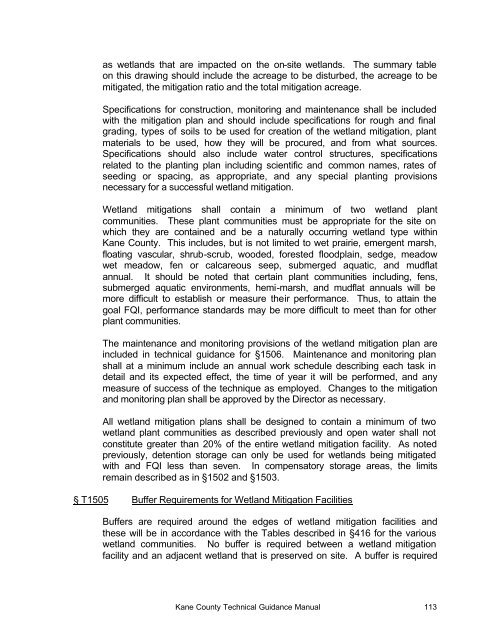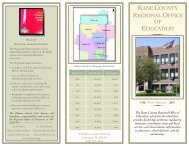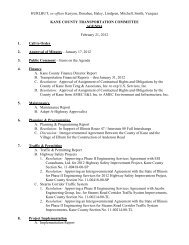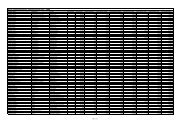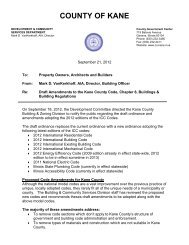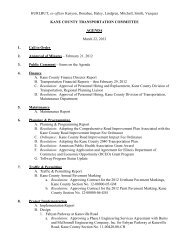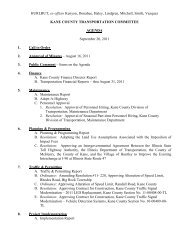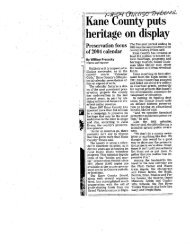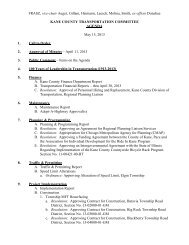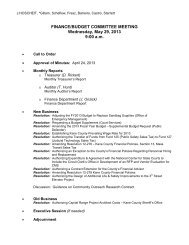kane county stormwater technical guidance manual - Kane County, IL
kane county stormwater technical guidance manual - Kane County, IL
kane county stormwater technical guidance manual - Kane County, IL
Create successful ePaper yourself
Turn your PDF publications into a flip-book with our unique Google optimized e-Paper software.
as wetlands that are impacted on the on-site wetlands. The summary table<br />
on this drawing should include the acreage to be disturbed, the acreage to be<br />
mitigated, the mitigation ratio and the total mitigation acreage.<br />
Specifications for construction, monitoring and maintenance shall be included<br />
with the mitigation plan and should include specifications for rough and final<br />
grading, types of soils to be used for creation of the wetland mitigation, plant<br />
materials to be used, how they will be procured, and from what sources.<br />
Specifications should also include water control structures, specifications<br />
related to the planting plan including scientific and common names, rates of<br />
seeding or spacing, as appropriate, and any special planting provisions<br />
necessary for a successful wetland mitigation.<br />
Wetland mitigations shall contain a minimum of two wetland plant<br />
communities. These plant communities must be appropriate for the site on<br />
which they are contained and be a naturally occurring wetland type within<br />
<strong>Kane</strong> <strong>County</strong>. This includes, but is not limited to wet prairie, emergent marsh,<br />
floating vascular, shrub-scrub, wooded, forested floodplain, sedge, meadow<br />
wet meadow, fen or calcareous seep, submerged aquatic, and mudflat<br />
annual. It should be noted that certain plant communities including, fens,<br />
submerged aquatic environments, hemi-marsh, and mudflat annuals will be<br />
more difficult to establish or measure their performance. Thus, to attain the<br />
goal FQI, performance standards may be more difficult to meet than for other<br />
plant communities.<br />
The maintenance and monitoring provisions of the wetland mitigation plan are<br />
included in <strong>technical</strong> <strong>guidance</strong> for §1506. Maintenance and monitoring plan<br />
shall at a minimum include an annual work schedule describing each task in<br />
detail and its expected effect, the time of year it will be performed, and any<br />
measure of success of the technique as employed. Changes to the mitigation<br />
and monitoring plan shall be approved by the Director as necessary.<br />
All wetland mitigation plans shall be designed to contain a minimum of two<br />
wetland plant communities as described previously and open water shall not<br />
constitute greater than 20% of the entire wetland mitigation facility. As noted<br />
previously, detention storage can only be used for wetlands being mitigated<br />
with and FQI less than seven. In compensatory storage areas, the limits<br />
remain described as in §1502 and §1503.<br />
§ T1505 Buffer Requirements for Wetland Mitigation Facilities<br />
Buffers are required around the edges of wetland mitigation facilities and<br />
these will be in accordance with the Tables described in §416 for the various<br />
wetland communities. No buffer is required between a wetland mitigation<br />
facility and an adjacent wetland that is preserved on site. A buffer is required<br />
<strong>Kane</strong> <strong>County</strong> Technical Guidance Manual 113


